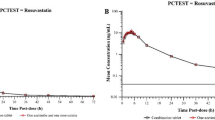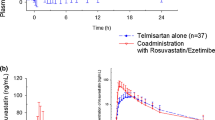Abstract
Background: Type 2 diabetes mellitus is associated with a 2- to 4-fold increased risk of coronary heart disease (CHD). Combined therapy with an antihyperglycaemic agent and an HMG-CoA reductase inhibitor (statin) is indicated for the treatment of diabetic patients at risk of CHD. Patients with type 2 diabetes are generally considered to be at equivalent cardiovascular disease risk to patients with established CHD, and should have low-density lipoprotein (LDL) cholesterol levels reduced to <100mg/dL or by 30–40%. Atorvastatin is the drug of choice for lowering LDL cholesterol levels. Metformin is the first therapeutic option in type 2 diabetes patients who are overweight or obese because it may also prevent vascular complications and mortality. Hence, a fixed-dose combination (FDC) of atorvastatin 10 mg and metformin 500 mg extended release (ER) was developed for patients with type 2 diabetes with or without hyperlipidaemia. Objectives: This study set out to establish bioequivalence between treatment 1 (test) — atorvastatin/metformin ER 10 mg/500 mg FDC, and treatment 2 (reference) — atorvastatin 10 mg (Lipitor®) and metformin 500 mg (Glucophage® XR) administered concurrently as individual tablets.
Methods: The study was a randomized, open-label, two-treatment, two-period, two-sequence, single-dose, crossover, bioequivalence study in 40 male subjects of Asian origin aged 18–45 years. The order of receiving the test and reference treatments for each subject during both the periods of the study was determined according to an SAS®-generated randomization schedule. The two treatments were separated by a washout period of 11 days. Blood samples were collected pre-dose and up to 72 hours post-dose in each period for determination of plasma atorvastatin/metformin concentrations and calculation of the respective pharmacokinetic parameters. ANOVA was performed on the lognormal-transformed pharmacokinetic parameters. A 90% confidence interval (CI) for the ratios of the test and reference product averages (least squares means) was calculated for atorvastatin and metformin to establish bioequivalence.
Results: The 90% CIs for atorvastatin and metformin were within the bioequivalence acceptance criteria of 80–125%. The 90% CIs obtained for atorvastatin for maximum plasma concentration (Cmax) area under the plasma concentration-time curve (AUC) from time zero to time of last measurable concentration (AUClast) and AUC from time zero to infinity (AUC∞) were (88.11, 106.93), (91.18, 107.94) and (89.25, 106.60), respectively. The 90% CIs observed for metformin for Cmax, AUClast, AUC∞ and AUC from time zero to 24 hours (AUC24) were (113.3, 124.0), (102.65, 117.97), (101.87, 116.82) and (102.44, 117.53), respectively. The two treatments were well tolerated by the study subjects.
Conclusion: Atorvastatin/metformin ER 10 mg/500 mg FDC has similar bioavailability to the co-administration of separate atorvastatin 10 mg and metformin 500 mg tablets. The FDC tablets show similar safety and tolerability profiles to their individual components. Therefore, atorvastatin/metformin ER 10 mg/500 mg FDC tablets can be used safely in clinical settings to decrease the pill burden and increase patient compliance with therapy.




Similar content being viewed by others
References
Cerveny JD, Leder RD, Weart CW. Issues surrounding tight glycemic control in people with type 2 diabetic mellitus. Ann Pharmacother 1998; 32: 896–905
Haffner SM. Management of dyslipidemia in adults with diabetes (Technical Review). Diabetes Care 1998; 21: 160–78
Third Report of the National Cholesterol Education Program (NCEP)-Adult Treatment Panel III (Final Report). National Heart, Lung, and Blood Institute, National Institutes of Health, NIH Publication No. 02-5215, Sep 2002 [online]. Available from URL: www.nhlbi.nih.gov/guidelines/cholesterol/atp3full.pdf [Accessed 2011 Aug 1]
O’Brien T, Nguyen TT, Zimmerman BR. Hyperlipidemia and diabetes mellitus. Mayo Clin Proc 1998 Oct; 73(10): 969–76
Malhotra HS, Goa KL. Atorvastatin: an updated review of its pharmacological properties and use in dyslipidaemia. Drugs 2001; 61(12): 1835–81
Plans-Rubió P. Cost-effectiveness analysis of cholesterol-lowering therapies in Spain. Am J Cardiovasc Drugs 2006; 6(3): 177–88
Jones PH, Davidson MH, Stein EA, et al. Comparison of the efficacy and safety of rosuvastatin versus atorvastatin, simvastatin, and pravastatin across doses (STELLAR* Trial). Am J Cardiol 2003; 92(2): 152–60
Colhoun HM, Betteridge DJ, Durrington PN, et al. Primary prevention of cardiovascular disease with atorvastatin in type 2 diabetes in the Collaborative Atorvastatin Diabetes Study (CARDS): multicentre randomised placebo-controlled trial. Lancet 2004; 364(9435): 685–96
Krentz AJ, Bailey CJ. Oral antidiabetic agents: current role in type 2 diabetes mellitus. Drugs 2005; 65(3): 385–411
Saenz A, Fernandez-Esteban I, Mataix A, et al. Metformin monotherapy for type 2 diabetes mellitus. Cochrane Database Syst Rev 2005; 3: CD002966
Bangalore S, Kamalakkannan G, Parkar S, et al. Fixed-dose combinations improve medication compliance: a meta-analysis. Am J Med 2007; 120: 713–9
World Health Organization Technical Report Series, WHO Expert Committee on Specifications for Pharmaceutical Preparations. 39th report. Annex 5: Guidelines for registration of fixed-dose combination medicinal products. No. 929, Geneva 2005 [online]. Available from URL: www.who.int/prequal/.../TRS929/WHO_TRS_929_annex5FDCs.pdf [Accessed 2011 Aug 1]
Turner RC, Millns H, Neil HA, et al. Risk factors for coronary artery disease in non-insulin dependent diabetes mellitus (UKPDS 23). Brit Med J 1998; 316: 823–8
Herman WH, Alexander CM, Cook JR, et al. Effect of simvastatin treatment on cardiovascular resource utilization in impaired fasting glucose and diabetes: findings from the Scandinavian Simvastatin Survival Study. Diabetes Care 1999; 22: 1771–8
Plehn JF, Davis BR, Sacks FM, et al. Reduction of stroke incidence after myocardial infarction with pravastatin: the Cholesterol And Recurrent Events (CARE) study. Circulation 1999; 99: 216–23
De Caterina R, Scarano M, Marfisi R, et al. Cholesterol-lowering interventions and stroke: insights from a meta-analysis of randomized controlled trials. J Am Coll Cardiol 2010 Jan 19; 55(3): 198–211
Scheen AJ. Clinical pharmacokinetics of metformin. Clin Pharmacokinet 1996 May; 30(5): 359–71
Scheen AJ. Drug interactions of clinical importance with antihyperglycaemic agents. Drug Safety 2005; 28(7): 601–31
Balasubramanian R, Varadharajan S, Kathale A, et al. Assessment of the efficacy and tolerability of a fixed dose combination of atorvastatin 10 mg+metformin SR 500 mg in diabetic dyslipidaemia in adult Indian patients. J Indian Med Assoc 2008 Jul; 106(7): 464–7
Tousoulis D, Koniari K, Antoniades C, et al. Combined effects of atorvastatin and metformin on glucose-induced variations of inflammatory process in patients with diabetes mellitus. Int J Cardiol 2011 May 19; 149(1): 46–9
Newman CB, Szarek M, Colhoun HM, et al. The safety and tolerability of atorvastatin 10 mg in the Collaborative Atorvastatin Diabetes Study (CARDS). Diab Vasc Dis Res 2008; 5(3): 177–83
Nathan DM, Buse JB, Davidson MB, et al. Management of hyperglycemia in type 2 diabetes: a consensus algorithm for the initiation and adjustment of therapy. A consensus statement from the American Diabetes Association and the European Association for the Study of Diabetes. Diabetes Care 2006; 29(8): 1963–72
Khurana R, Malik IS. Metformin: safety in cardiac patients. Postgrad Med J 2010; 86: 371–3
Evans JMM, Donnelly LA, Emslie-Smith AM, et al. Metformin and reduced risk of cancer in diabetic patients. Brit Med J 2005; 330: 1304–5
Acknowledgements
This study was sponsored by Ranbaxy Research Laboratories, India. Kirti Kandhwal, Surajit Dey, Shabana Nazarudheen, Rachna Arora, Simrit Reyar, Nageshwar R. Thudi and Tausif Monif are employees of Ranbaxy Research Laboratories, India. Manoj K. Singh and Shireen Rao are employees of Fortis Clinical Research Limited, India. The authors wish to thank the clinical site staff and subjects for their contributions to this study.
Author information
Authors and Affiliations
Corresponding author
Rights and permissions
About this article
Cite this article
Kandhwal, K., Dey, S., Nazarudheen, S. et al. Pharmacokinetics of a Fixed-Dose Combination of Atorvastatin and Metformin Extended Release versus Concurrent Administration of Individual Formulations. Clin. Drug Investig. 31, 853–863 (2011). https://doi.org/10.1007/BF03256923
Published:
Issue Date:
DOI: https://doi.org/10.1007/BF03256923




